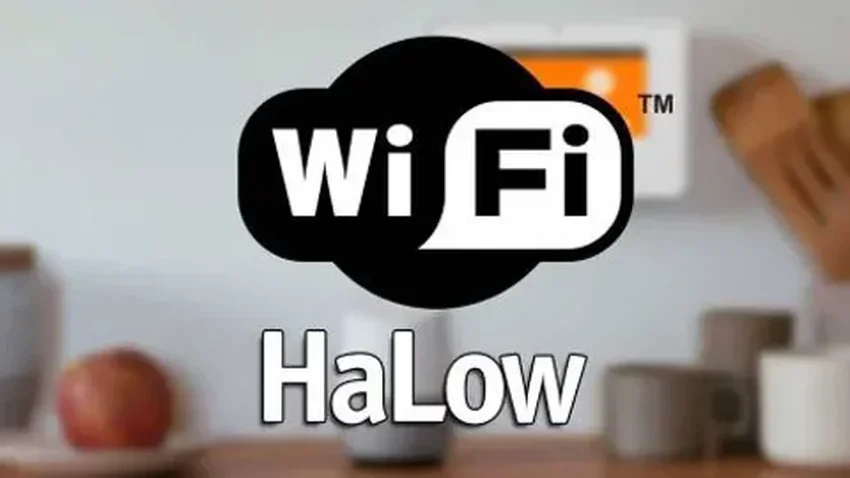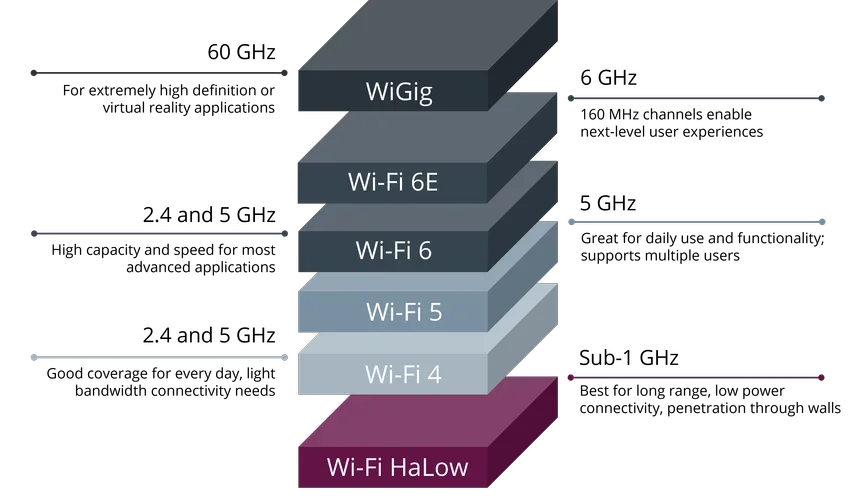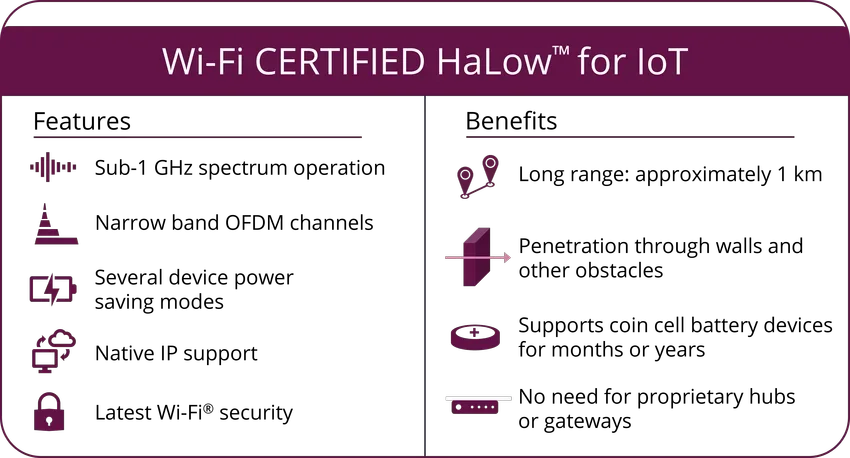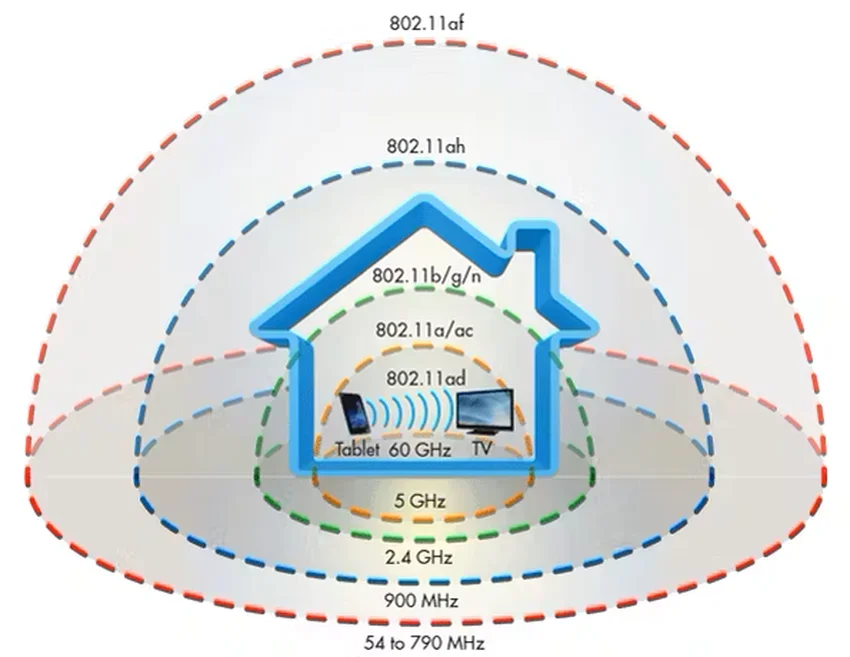Wi-Fi CERTIFIED HaLow™ is a wireless technology based on the IEEE 802.11ah protocol, built specifically for IoT and operating in a spectrum below 1 gigahertz (GHz) to provide long signal range with low power consumption.

And while the classic Wi-Fi standard these days aims to introduce high-capacity variants like WiGig and Wi-Fi 6E, a new emerging technology called Wi-Fi HaLow is quietly arriving and poised to transform the landscape of Wi-Fi. Internet of Things (IoT).
What is Wi-Fi HaLow?

The Wi-Fi HaLow is a specification of your familiar wireless technology based on the IEEE 802.11ah protocol. First introduced in 2016, it runs at frequencies below 1 GHz, unlike the traditional Wi-Fi 5, Wi-Fi 6, Wi-Fi 6E and Wi-Fi 7 protocols, which use 2,4 GHz frequencies. 5 GHz and 6 GHz.
And since lower frequencies can travel longer distances, Wi-Fi HaLow can provide connectivity up to a kilometer and even further if there is line-of-sight between the two points.
However, using a lower frequency also means it has narrower channels and lower bandwidth, resulting in slower data rates. It can provide data speeds from 150 Kbps over long distances and up to 86,7 Mbps over shorter distances.
It does not replace traditional Wi-Fi standards. Instead, it's designed to complement existing Wi-Fi protocols and offer connectivity to devices over longer distances without the need for wireless extenders, multiple access points, and complex hard-wired connections.
This opens up a number of IoT use cases, especially for small facilities such as academic and research institutions, industrial facilities and offices. In addition, a wide range of industrial applications, smart cities and smart buildings and agricultural applications can be supported. It is suitable for mesh networking (mesh).

In the US, Wi-Fi HaLow operates on the 900 Hz frequency which is part of the license-exempt spectrum, making it free for everyone to use.
However, depending on the countries and which sub-gigahertz frequencies are available for each one, Wi-Fi HaLow can operate on different frequencies.
Differences of Wi-Fi HaLow from classic Wi-Fi?

Traditional Wi-Fi protocols have made significant advances in wireless speeds, but signal range has suffered precisely because of this rush for speeds.
Wi-Fi HaLow is an attempt to correct this lag in the suite capabilities of Wi-Fi, particularly in a world where IoT devices are growing exponentially and need a reliable way to stay constantly connected to each other and to the Internet.
So, as mentioned, Wi-Fi HaLow provides much better transmission range than conventional Wi-Fi. Using a lower frequency means it penetrates better in obstacles such as walls, windows, etc. Roughly similar to how 2,4 GHz Wi-Fi offers better signal range and wall penetration than the 5 GHz and 6 GHz Wi-Fi bands.
HaLow also consumes much less power, as it can remain in a low-power state thanks to the various sleep modes defined in the 802.11ah specification.

Thus, it can serve battery-powered devices such as sensors, wireless security cameras, and more, and help them run for months or even years without needing to replace or charge the battery.
A comparison study published by the Wi-Fi Alliance revealed that the duration battery life for HaLow Wi-Fi devices using 500 mAh batteries at ten-minute transmission intervals can reach 3,15 years, far exceeding the lifetime of other low-power wide area (LPWAN) technologies.
Another advantage of Wi-Fi HaLow over traditional Wi-Fi is its ability to connect to more than 8.000 devices simultaneously, compared to Wi-Fi 6 which can only connect to 2007 simultaneously.
Alternative to Z-Wave, Zigbee, Thread

Wi-Fi HaLow is not the first wireless technology to bring connectivity to IoT devices. Other wireless technologies such as Z-Wave, Zigbee and Thread already exist. But each has its own advantages and disadvantages.
The closest thing to Wi-Fi HaLow is Z-Wave, as it is similar from many opinions. It also uses frequencies below 1 GHz and thus has a longer range and low power consumption. But although it has a long transmission range, it is not equivalent in range to HaLow.
A single Z-Wave network also cannot support more than 232 devices. Additionally, you need a controller to effectively operate Z-Wave devices.
Informatively, the Z-Wave Alliance introduced in 2020, a new Z-Wave Long Range version, which brings the signal range to the level of Wi-Fi HaLow and increases the number of supported devices in a Z-Wave network to 4.000.
Zigbee, on the other hand, operates on the 780MHz, 868Hz, 915MHz and 2,4GHz frequencies. However, most Zigbee devices for home use use the 2,4 GHz band. Thus, it has a faster data transfer rate than Z-Wave but a limited range.
It also doesn't have the best interoperability record, isn't as secure as Wi-Fi, and needs a "moderator" device to control the network. It can support over 65.000 nodes in a single network, much higher than Z-Wave and even Wi-Fi HaLow.
Thread is one of the newer low-power wireless protocols. It also uses the 2,4GHz frequency to connect and communicate with other Thread devices. Thread devices are IP-based and can connect to each other without a hub or bridge. But they still need a Thread router to connect the Thread network to the internet.
Thread networks are also limited to around 250 devices and are not ideal for relatively high bandwidth devices such as security cameras.
So while each of these special low-power wireless protocols does many things right, each has its drawbacks.
In comparison, HaLow Wi-Fi has impressive signal range, no hub needed, excellent security, can connect to over 8.000 devices, and has reasonable data speeds.
Plus, you get seamless interoperability, and by using a different band than existing Wi-Fi networks, HaLow doesn't clog existing infrastructure.
Wi-Fi HaLow is a real alternative even for LoRaWAN, Bluetooth Low Energy and NarrowBand-IoT (NB-IoT) systems. It is important to say that the data rate is sufficient for streaming video over the network, setting HaLow apart from LoRa, Sigfox and NB-IoT, plus of course standard Wi-Fi.
Using Wi-Fi HaLow

Wi-Fi HaLow has application in a variety of situations, but home users will see the biggest impact on smart home IoT devices, as well as mesh networking systems.
Almost every smart home device needs wireless access for connectivity, the 2,4 GHz wireless band is the most congested as it can have only three non-overlapping channels.
But Wi-Fi HaLow operates on a completely different frequency than conventional Wi-Fi and can have more than 26 non-overlapping channels. As a result, the chances of interference and congestion are almost negligible, unless you have thousands of connected devices in your home competing to speak first.
In addition, its extensive range allows it to serve IoT and smart home devices from a single access point to huge properties.
So, for example, if you have a cottage with a garden, you'll need a single router or mesh system to cover your main residence to serve high-bandwidth devices. But with Wi-Fi HaLow, myself router or mesh system can also cover your entire garden and property perimeter, incorporating sensors, security cameras, outdoor doorbells and other relatively low bandwidth devices into the system.
This removes the need to wire the entire property or install additional mesh nodes or Wi-Fi extenders to get extended signal coverage.
Outdoor cameras, for example, can be supported by HaLow because low-power cameras can be installed without their signal being blocked by trees or other obstacles.
This could be used to monitor cattle on a farm or to manage multi-dwelling or office units, including underground car parks.
How can you get HaLow Wi-Fi?

As with any Wi-Fi system, you need both the wireless router and the device to support Wi-Fi HaLow to take advantage of its benefits.
Unfortunately, the integration of Wi-Fi HaLow protocol in devices is slow, but with increasing interest, we will see more devices with this Wi-Fi specification in the future.
In addition, some manufacturers have launched Wi-Fi extensions that incorporate HaLow, to extend the range of a wireless network to hundreds of meters.
In terms of devices, Abode showed off a new security camera at CES 2024 called Edge, which uses HaLow Wi-Fi and is expected to hit the market in Q1 2024 for around $200.
The Taiwanese manufacturer Chicony designs also introduce security cameras that use Wi-Fi HaLow.
Unfortunately, your existing wireless router almost certainly won't be able to support the benefits of HaLow, not even through a firmware upgrade, as HaLow requires new hardware.
As is the case with devices that support Wi-Fi 6E, since they cannot access Wi-Fi 7 simply with a software update.
In short, Wi-Fi HaLow completes the Wi-Fi family by providing the much needed and still underrated part of connectivity: Namely, the combination of extended range, long battery life and low bandwidth.





